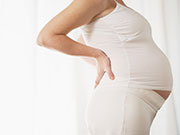
FRIDAY, Feb. 14, 2014 (HealthDay News) — More than 14 percent of American women take powerful narcotic pain medications during pregnancy, according to a large new study.
Since these drugs, which may cause addiction, are so often prescribed to pregnant women, the study authors called for more research to determine how safe they are for unborn babies.
The study was published online Feb. 12 in the journal Anesthesiology. It looked at the use of medications, including narcotics such as Vicodin and Oxycontin — also known as opioids — in more than 530,000 pregnant women who gave birth between 2005 and 2011 in the United States.
“Nearly all women experience some pain during pregnancy,” study author Dr. Brian Bateman, an assistant professor at Harvard Medical School, said in a journal news release. “However, the safety of using opioids to manage their pain remains unclear. Ultimately, we need more data to assess the risk/benefit ratio of prescribing these drugs to women and how it may affect their babies.”
The average of women in the study was 31. Using a database on pregnant women enrolled in a commercial insurance plan, the researchers looked at which medications were most often prescribed, what pain was most often being treated with these drugs and how use of the drugs varied in different regions of the country.
Most of the women who took narcotic painkillers did so for less than a week. Slightly less than 6 percent of women in their first or second trimester were prescribed the painkillers, while 6.5 percent of women in their third trimester received the medications, the study found.
The researchers pointed out that 2.2 percent of the women in the study received a prescription for narcotics three or more times throughout their pregnancy.
The most common reason women were given the pain medications was back pain, which affected 37 percent of the study’s participants. Other reasons the women used them included abdominal pain, migraine, joint pain and fibromyalgia.
Prescription narcotic use among pregnant women is more common in the United States than in Europe, the researchers said. Among American women, those living in the South used the drugs more than women living in other parts of the country. Arkansas, Mississippi and Alabama all had prescription rates of more than 20 percent. Meanwhile, women living in the Northeast had the lowest prescription rates, at 6.5 percent.
Hydrocodone (Vicodin) was the most-prescribed drug — to 6.8 percent of the women, the study found. Meanwhile, 6.1 percent of the women took codeine, 2 percent took oxycodone (Oxycontin) and 1.6 percent took propoxyphene (Darvon).
In response to the study’s findings, Dr. Pamela Flood, a professor of anesthesiology, pain and perioperative medicine at Stanford University, said, “The risk to the fetus of short-term exposure to prescription opioids under medical supervision is difficult to assess and needs to be carefully examined in future studies.”
Flood noted that previous studies on the risks of opioid use on unborn babies have been contradictory. Although one U.S. study conducted between 1997 and 2005 found a link between some of these drugs and specific birth defects, previous studies found no association.
More information
The U.S. National Institute on Drug Abuse has more about opioids.
Copyright © 2025 HealthDay. All rights reserved.

